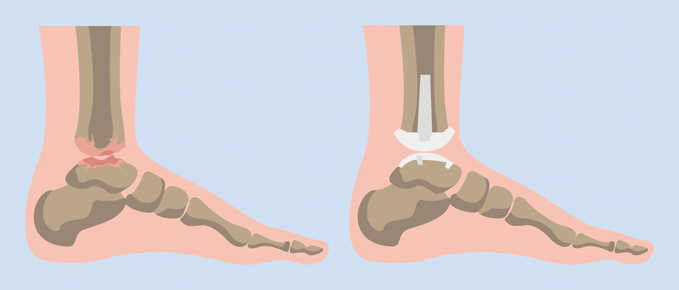Total Ankle Replacement

What is a total ankle replacement?
Total ankle replacement, also known as total ankle arthroplasty, is a treatment option offered to patients in whom non-surgical options have been ineffective in controlling pain due to ankle arthritis. Arthritis or joint inflammation of the ankle can develop due to acute or chronic conditions such as injuries, leading to stiffness, pain and difficulty walking. The ankle joint is the connection point of the lower leg bone (tibia) and upper foot bone (talus). Normally, the ends of these bones are made up cartilage that allows the lower leg and foot to move in smooth, painless motion. In arthritic patients, depending on the degree of cartilage loss, pain and limited mobility can occur.
Until recently, advanced arthritis that is very painful has been treated primarily with ankle fusion. This procedure obliterates the ankle joint completely. Pain is relieved, but at the cost of absolute stiffness. A newer procedure gaining popularity has been total ankle replacement. Total ankle replacement involves removal of arthritic bone and cartilage and replacement with implants made of metal and plastic. These components allow the ankle joint to move smoothly, mimicking the cartilage that was lost.
How long does a total ankle replacement procedure take, and how long is recovery?
The overall procedure will take approximately 2-3 hours. Most patients are discharged between 2-3 days later with an overall recovery period between 6-12 months. The ankle replacement components will likely last for at least 10 years, but it can vary depending on the patient’s health and activity level.
What are the benefits and risks of total ankle replacement surgery?
The primary benefit of total ankle replacement is decreased pain. Some, but not all patients, may experience increased range of motion with better mobility. The risks include infection, injury to blood vessels and/or nerves, fracture, failure of bone to heal and loosening of implant components. Your Rubin Institute for Advanced Orthopedics doctor can evaluate your particular situation and advise you on the relative risks and likelihood of success after total ankle replacement.
Why choose the International Center for Limb Lengthening for total ankle replacement surgery?
With a collective experience of over thirty years of helping patients with lower leg, foot and ankle problems, the Foot and Ankle Service of the Rubin Institute is one of the leading treatment centers for foot and ankle conditions in the United States. Our patients benefit from our team-centered approach with world-renowned surgeons and specialized physician assistants, nurses and physical therapists. We help patients with total ankle replacement surgery achieve their best possible result.
